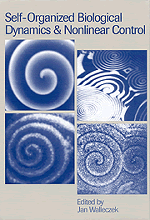 Self-Organized Biological Dynamics and Nonlinear Control
Self-Organized Biological Dynamics and Nonlinear Control Published online by Cambridge University Press: 14 August 2009
Introduction
Between regularity and randomness lies chaos. Our prevailing scientific paradigms interpret irregularity as randomness. When we see irregularity, we chauvinistically cling to randomness and disorder as explanations. Why should this be so? Why is it that, when the ubiquitous irregularity of biological systems is studied, instant conclusions are drawn about randomness and the whole vast machinery of probability and statistics is belligerently applied? Recently we have begun to realize that irregularity is much richer than mere randomness can encompass. Thus, we are brought to chaos.
Sustained irregularity has always upset our notions of how the world should behave. Yet it seems to be the canonical behavior of biological systems. One informal definition of chaos, sustained irregular behavior, although descriptive, is too vague to define the rich behavior of chaotic systems. A more precise defining feature of chaotic systems is their sensitivity to initial conditions (e.g., see Baker and Gollub, 1990). It is this definition that we will utilize for the characterization and control of chaotic systems.
Fleeting glimpses of order within disorder are quite common. We have all seen short stretches of almost periodic behavior in otherwise irregular systems. A tantalizing example lies in the stock market, where many hope to reap windfall fortunes from analyzing short-term order and predicting the volatile market. But short-term order is a profound, even defining, feature of chaotic systems.
To save this book to your Kindle, first ensure [email protected] is added to your Approved Personal Document E-mail List under your Personal Document Settings on the Manage Your Content and Devices page of your Amazon account. Then enter the ‘name’ part of your Kindle email address below. Find out more about saving to your Kindle.
Note you can select to save to either the @free.kindle.com or @kindle.com variations. ‘@free.kindle.com’ emails are free but can only be saved to your device when it is connected to wi-fi. ‘@kindle.com’ emails can be delivered even when you are not connected to wi-fi, but note that service fees apply.
Find out more about the Kindle Personal Document Service.
To save content items to your account, please confirm that you agree to abide by our usage policies. If this is the first time you use this feature, you will be asked to authorise Cambridge Core to connect with your account. Find out more about saving content to Dropbox.
To save content items to your account, please confirm that you agree to abide by our usage policies. If this is the first time you use this feature, you will be asked to authorise Cambridge Core to connect with your account. Find out more about saving content to Google Drive.